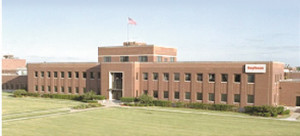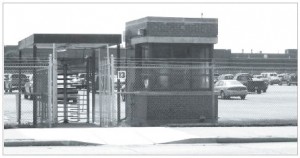In 1942, the United States was focused on Europe and the Pacific Ocean. The U.S. was forced to join the hostilities by the Pearl Harbor attack and we had only be at war a few months. Everyone was trying to do their part to help our boys be victorious as they fought Germany and Japan. Many businesses and factories turned to war production and increased their output of goods and services as they related to helping the war effort. Indianapolis was no exception.
New production facilities were springing up everywhere and both men and women were going to work in numbers never been seen before. In the spring of 1942, few people took notice when an isolated tract of land bounded on the north by 21st Street and south by 16th Street and west by Arlington Ave and east close to Road 100 or Shadeland Avenue as it was starting to be called, was being cleared, drained, and graded in what seemed to be a massive construction project. It came to 163 acres. Not that many folks resided in the area at the time and there was a great deal of undeveloped farmland on that area on the east side. There was some speculation as to what was being constructed. A prisoner of war or Japanese American interment camp? A military induction center or ammunition depot? It was even rumored that a military airfield was being built that would be connected to Fort Harrison. People working on the project were ordered to keep a tight lip, but that was standard operating procedure for just about any endeavor during the war, even to growing a personal vegetable garden. People were suspicious of anyone who asked questions.
Actually, in 1939, when the war in Europe broke out, the United States Bureau of Ordnance determined that five in-shore facilities should be built for the manufacture of naval ordnance equipment. Indianapolis was selected because it was centrally located, it was a railroad center, and was far enough inland that it could not easily be bombed by enemy aircraft. The land was acquired in 1940 and the plans for the construction of the facility began to be drawn. In 1941, the budget for the project was put together and the first clearing started. However, after December 7, the project went into high gear to become operational ASAP. In 1943, the Center became fully operational as the Lukas-Harold Corporation, although most folks called it the Naval Ordnance Plant (NOP).
The secret was that the Norden Bombsight was being developed and constructed for naval use at the NOP. The Norden Bombsight has been called the technology that won the war in Europe for the Allies and its technology and design were top secret. It was developed by Dutch engineer Carl Norden, who had come to America in 1904. He developed the bomb sight in 1931 but as the speed of airplanes increased and the altitude at which they could fly increased, his company had to keep updating and improving the bomb sight. By 1942 the bomb sight had been automated and advanced to the point where American Army Air Corp and Navy bombers could drop bombs with greater accuracy and at a much higher altitude than ever before. This increased the range of the American bombers, helped them better dodge enemy anti-aircraft fire, and more accurately take out the designated targets. When the Enola Gay flew over Hiroshima and dropped the A-Bomb, the bombardier used a Norden Bombsight.
By 1944, the Indianapolis Naval Ordnance plant was the leading producer of the Norden Bombsights. Other ordnance was being produced there, but it was the bombsight that was the key. While many Indianapolis residents had become aware of the plant’s existence, because the project was so top secret, very, very few were aware of what was being made there. Even after the war was over, much of the NOP production was hush-hush. It was a number of years before the general public was made aware of what had been happening at the facility during the war. The Indianapolis plant received the Navy’s “E” flag for excellence in service in 1943, 1944, and 1945.
In 1945 the Navy took full control of the plant and it officially became the Naval Ordnance Plant, Indianapolis or NOP-I and an official United States Navy Base. In 1956 the plant became the Naval Avionics Facility, Indianapolis or NAFI which is the acronym I always remember it being called. By that time the Cold War was in full swing and the plant was producing ordnance technology for all American Armed Services. The Vietnam War saw more avionic technology from NAFI. It became the Naval Avionics Center in 1977. They developed and produced missile technology for the First Gulf War. The Naval Base closed in 1995 and the plant reverted to private hands and was acquired by Raytheon Technologies who still have the property. There is still production there, but on a much smaller scale with a greatly reduced work force. The old naval personnel quarters that lined the north side of 16th Street have been flattened and a senior community is currently being constructed. The loss of NAFI put a real dent in the east side economy. If you lived on the Indianapolis east side, you either worked there or knew someone who did, but no more.
The Naval Ordnance Plant or Naval Avionics Facility Indianapolis is starting to become a faded memory. But its role in producing the Top Secret that helped United States Air Forces to victory in World War II and the part it played in helping the United States stay safe and secure in the next 40 years of it’s existence can never be forgotten.
On a personal note, I was an Indianapolis Public Librarian in the Extension Division at the NAFI library station by the cafeteria every Wednesday. On one particular Wednesday, while opening the station for business, I got the call that my wife was in labor with my son Chris. I left for home as quickly as I could and the rest is family history – that was very nearly thirty years ago. snicewanger@yahoo.com
snicewanger@yahoo.com




